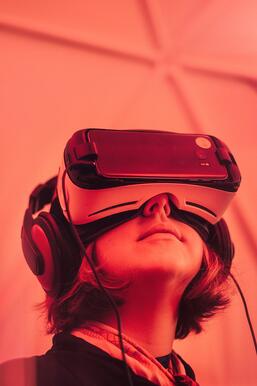From CampusBird Blog
By: Zack Mertz
The following post offers insight about how higher education professionals can get started with virtual reality, and includes costs, how-to’s and other important information you need to know.
There’s a lot of excitement about virtual reality. And there should be. It’s exciting, in its infancy, and reports say VR will be a $38 billion dollar industry by 2026.
But there also seems to be a lot of confusion about virtual reality.
What does virtual reality mean? Do universities and colleges even need virtual reality? And if so, how can they affordably integrate virtual reality affordably? How can they make sure that an investment in VR pays off?
Our team talks about this often, because many of our existing and prospective clients are interested in or already pursuing some type of virtual reality. They understand how powerful virtual reality can be in providing an experience that’s both memorable and influential. They know that it can be a deciding factor in a student’s decision to schedule a visit and ultimately submit their application.
In this post, we set out to answer the following question: what are three options and costs to integrate virtual reality into higher education websites?
What is Virtual Reality?
Virtual reality is the creation of a simulation using 3D images or modeling, and which can be interacted with using special hardware. He hears a lot about that hardware these days. But the content…not quite as much :) In this post, Virtual Reality for Higher Education: Beyond the Virtual Tour, we discuss how VR can be used by higher education professionals across many different departments.
If you’d like a primer on VR (and how it compares to augmented reality e.g. Pokemon Go), check out this short video with Noah Robischon and Mark Wilson from Fast Company.
So let’s get started. We’ll go from most accessible and affordable on up.
VR-Enabled 360 Panorama Images
Cost: $ to $$ (depends on the number of images desired)
What You Need: A 360 degree camera or 360 degree camera app, conversion software and a place to put the images. May we suggest a campus map, perhaps :)
There are many companies that specialize in providing 360 degree photospheres.
What Your Audience Needs: A VR-ready setup to view your images – anything from Google Cardboard ($10) on up to Oculus Rift ($600) will do.
How it Works/What You Should Know:
VR-enabled 360 images allow the visitor to explore a fixed area in 3D virtual reality, allowing the user to move the image around in order to view anything captured in the image – up, down, left, right. If you’re a higher education professional looking to get some VR content on your website – and do so affordably – 360 photospheres are a great way to start. Pick your most interesting locations – exteriors (e.g. the quad, famous vistas, stadiums, historic buildings) and spacious interiors (e.g. a library, student center, arena, etc.), and capture the 360 image. Also think about what students will want to see – dorm rooms, student center cafeteria, unique and fun aspects of your campus.
Here’s an example from HoloBuilder, an application that allows you to create a VR/AR experience with a 360 photosphere. There are several applications (including Facebook) where you can convert 360 images to VR
Virtual Reality Guided Campus Tours
Cost: $$ to $$$$ (depends on length, vendor and number of images used)
What You Need: Software to create virtual guided tours, or a company that specializes in creating guided virtual tours.
What Your Audience Needs: The hardware needs are the same as for the 360 photospheres – anything from Google Cardboard to the Google Daydream and Oculus Rift will do!
How it Works/What You Should Know: Think of virtual reality guided tours as a video production that strings together a number of VR-ready 360 photospheres. Many universities have them, and they can be attractive and engaging. A downside is that virtual guided tours limit students’ ability to openly explore your campus, forcing them to stay within the track of the tour.
Another drawback is that, with some vendors, you don’t actually own any of the media or assets that comprise your guided tour, so you cannot use them for other promotional needs online. You may want to negotiate the ability to include several guided tour changes in the initial price because (following the video production comparison) to make changes to the finished tour can be quite costly.
But guided tours can be influential and enjoyable for students.
Virtual Reality – 3D Immersive Campus Model
Cost: $$$ to $$$$+
What You Need: A company or team to build a 3D model of your campus, buildings and interiors. Like 360 panos, these 3D models are then processed through software to create the virtual reality experience. The maps developed by CampusBird for our clients are VR-ready 3D models.
What Your Audience Needs: A virtual reality headset with the ability to navigate.
How it Works/What You Should Know: This is often what comes to mind when people think of virtual reality (think Second Life). It’s more expensive because it requires the development of a full 3D model of the area where your audience will be virtually exploring, and it also requires a lot of computing power (on both sides). But this is changing. Gaming is leading the charge on 3D immersive models, and we’re likely to see a rapid acceleration in 2017 as new hardware (and VR content) further penetrates the market. This will mean that more students and perhaps even their parents will be ready to access and more interested in virtual reality.
VR Offers Big Potential for Higher Ed Professionals
It’s an exciting time for virtual reality, and higher education professionals have huge opportunity to leverage this excitement (and the increasing affordability) to create immersive campus experiences that can not only be used for marketing and admissions, but also for learning experiences as well.

